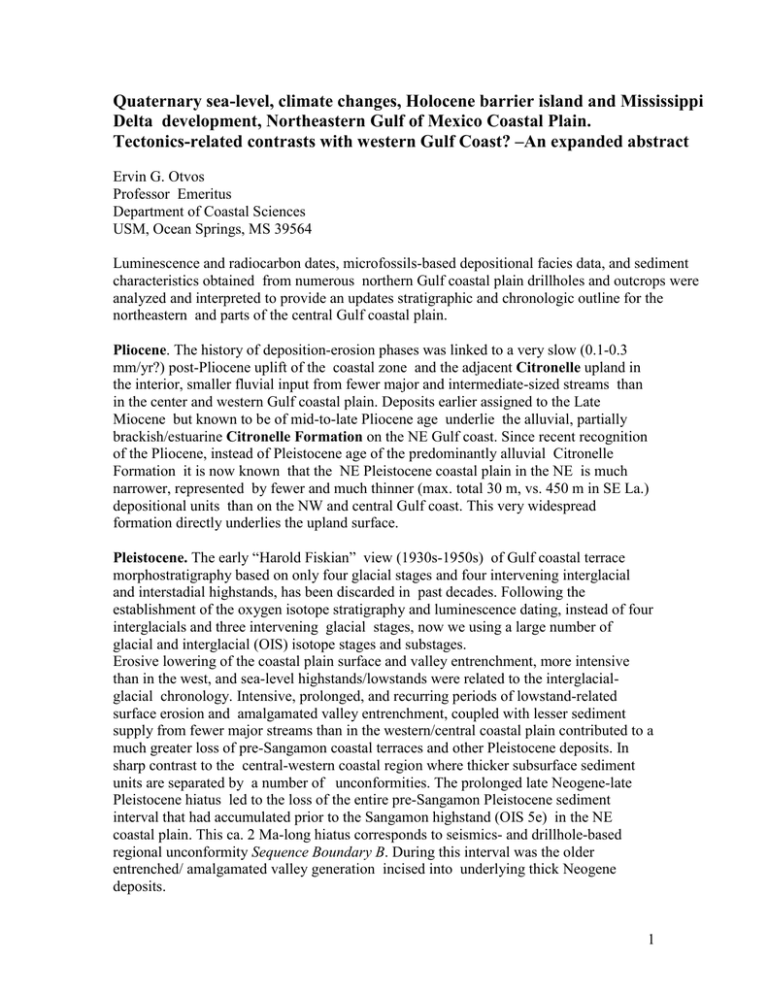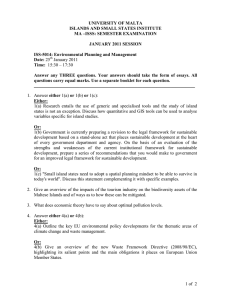Quaternary sea-level, climate changes, Holocene barrier island and Mississippi
advertisement

Quaternary sea-level, climate changes, Holocene barrier island and Mississippi Delta development, Northeastern Gulf of Mexico Coastal Plain. Tectonics-related contrasts with western Gulf Coast? –An expanded abstract Ervin G. Otvos Professor Emeritus Department of Coastal Sciences USM, Ocean Springs, MS 39564 Luminescence and radiocarbon dates, microfossils-based depositional facies data, and sediment characteristics obtained from numerous northern Gulf coastal plain drillholes and outcrops were analyzed and interpreted to provide an updates stratigraphic and chronologic outline for the northeastern and parts of the central Gulf coastal plain. Pliocene. The history of deposition-erosion phases was linked to a very slow (0.1-0.3 mm/yr?) post-Pliocene uplift of the coastal zone and the adjacent Citronelle upland in the interior, smaller fluvial input from fewer major and intermediate-sized streams than in the center and western Gulf coastal plain. Deposits earlier assigned to the Late Miocene but known to be of mid-to-late Pliocene age underlie the alluvial, partially brackish/estuarine Citronelle Formation on the NE Gulf coast. Since recent recognition of the Pliocene, instead of Pleistocene age of the predominantly alluvial Citronelle Formation it is now known that the NE Pleistocene coastal plain in the NE is much narrower, represented by fewer and much thinner (max. total 30 m, vs. 450 m in SE La.) depositional units than on the NW and central Gulf coast. This very widespread formation directly underlies the upland surface. Pleistocene. The early “Harold Fiskian” view (1930s-1950s) of Gulf coastal terrace morphostratigraphy based on only four glacial stages and four intervening interglacial and interstadial highstands, has been discarded in past decades. Following the establishment of the oxygen isotope stratigraphy and luminescence dating, instead of four interglacials and three intervening glacial stages, now we using a large number of glacial and interglacial (OIS) isotope stages and substages. Erosive lowering of the coastal plain surface and valley entrenchment, more intensive than in the west, and sea-level highstands/lowstands were related to the interglacialglacial chronology. Intensive, prolonged, and recurring periods of lowstand-related surface erosion and amalgamated valley entrenchment, coupled with lesser sediment supply from fewer major streams than in the western/central coastal plain contributed to a much greater loss of pre-Sangamon coastal terraces and other Pleistocene deposits. In sharp contrast to the central-western coastal region where thicker subsurface sediment units are separated by a number of unconformities. The prolonged late Neogene-late Pleistocene hiatus led to the loss of the entire pre-Sangamon Pleistocene sediment interval that had accumulated prior to the Sangamon highstand (OIS 5e) in the NE coastal plain. This ca. 2 Ma-long hiatus corresponds to seismics- and drillhole-based regional unconformity Sequence Boundary B. During this interval was the older entrenched/ amalgamated valley generation incised into underlying thick Neogene deposits. 1 While only 10-20 km, locally >1 km wide on the northeast Gulf, in the western and central coastal plain the Pleistocene coastal plain terraces widens to 50-100 km. The alluvial Montgomery Terrace, present only in fragments west of Mobile Bay in the NE, formed during the penultimate marine highstand (OIS 7, 216-188 ka). Stage OIS 6 lowstand coincided with valley entrenchment, including valleys of major present coastal plain streams (Pearl, Amite, etc.) and subsequently filled, buried valleys offshore The Sangamon interglacial coastal complex (OIS 5e Substage, 135-114 ka) consists of the paralic-to-open marine muddy-sandy transgressive Biloxi Formation, the highstand Gulfport Formation barrier strandplain sectors and Prairie Formation alluvium that extends into the Wisconsin dry, glacial stages of lower sea-levels (OIS 4, 3). Heavy mineral mapping, in sharp contrast to the single Appalachian province E of the Mississippi River, identified three source provinces in SW Louisiana (Mange and Otvos, 2004). Several recently dated (so-called “Deweyville”) valley terrace generations, have aggraded mostly between ca. 88-18 ka BP during the Wisconsin glacial stage in the Pearl, Amite, Sabine, and other incised coastal plain valleys (Otvos, 2005c). This age spread is much wider than earlier assumed. Wisconsin and early Holocene eolian inland dunes and sand sheets, dated between 68-7 ka BP formed under drier climate covered these ridges on the NW Florida coast and occur also in SE Louisiana. Development of the youngest, “Pleistocene-Holocene” regional unconformity that defines Sequence Boundary A was initiated at the conclusion of the Sangamon record sea-level high, ca. + 7 m. The climax of post-Sangamon valley entrenchment occurred during the brief LGM record lowstand, ca. 22-18 ka during OIS 2 when the global (“eustatic”) sea-level stood at ca. -125 m. Time-transgressive development of this unconformity in conjunction with the very lowly advancing transgression involves blanketing of the eroding present land surface with paralic sediments as sea-level rises. Holocene Continued transgression and filling of entrenched valleys characterized the early Holocene, with sporadic eolian activity in the occasionally dry interior. Sea-level stood at -10 m at, 8,000 cal yr BP; ca. -3 m at 4 ka. Recent ideas proposed for a higher than present (max. +2 m) mid-late Holocene sea-level stages on the northern Gulf have been discredited for lack of reliable evidence. The rate of ice-melting related sea-level rise rate on the northern Gulf was a steep 9 mm/yr until ca. 8 ka BP when most northern ice caps disappeared. It slowed to 4.2 mm/yr by 7.5 ka, only 2 mm/yr by 4 ka, and 0.4-0.6 mm/yr by 2 ka (Otvos 2004b; Milliken et al., 2008). The effect of mid-through-late Holocene eustatic SL rise in the Mississippi delta complex was greatly enhanced by additional 1.5to- 15 mm/yr tectonic and sediment compaction-related subsidence. Resulting in transgressive sedimentary hemicycles, brackish water influx filled major and minor estuarine embayments (Mobile Bay, Apalachicola Bay, Lake Pontchartrain). Creating a regressive hemicycle, barrier spits/ island chain emergence and growth and delta progradation resulted in superimposed paralic sequences in the gradually enclosed embayments and the Mississippi Sound. As transgression slowed, local depositional regression led to strandplain progradation along the AL-FL shore, ca. 4-2 ka BP. In the 2 subsequent erosional phase, shore retreat followed with erosional truncation of the ridgeplain. The ca. 110 km long AL-MS barrier island chain, that before its late Holocene burial extended through the New Orleans area and created Mississippi Sound , was constructed from sand carried by the westward net littoral drift from the huge Mobile ebb-tidal delta. The easternmost island, east Dauphin, of “composite” origin, formed around an elevated core of remnant Pleistocene (Gulfport) barrier ridges. The other islands emerged by vertical aggradation and westward and gulfward progradation from the shallow seafloor through construction of an overlying sandy barrier platform (shoal) zone formed in shallow water after ca. 4.5 ka. Open marine sediments under the islands and upward reduction in the depositional salinity of the Mississippi Sound sedimentary sequence provide evidence for aggradational barrier genesis. Gulfward- and downdrift- prograded strandplains (ridges-and-swales) thus characterize most island surfaces in MS and LA. A sudden reduction in nearshore salinities revealed in and dated by foraminifer assemblages ca. 4.0-3.8 ka reflected start of substantial fresh water discharge from prograding Lobe #8 of the Mississippi-St. Bernard Delta complex, heavily impacting the nearshore in SW Mississippi as well. Shoaling and delta progradation stopped sand transmission west of Cat Island and buried the entire western island chain sector. Deep scouring of these island sands buried at shallow depths under delta deposits beneath a drainage canal levee contributed to the 2005 New Orleans flood catastrophe (Nelson and Leclair, 2006). As numerous recent radiocarbon dates show (Otvos and Giardino, 2004), despite challenging data by various authors (Russell and Russell, Fisk and McFarlan, Frazier, Törnqvist et al., etc.), the chronology of the Holocene Mississippi delta lobe complex due to its huge size and thickness is very far from being reliably documented in greater details. Törnqvist et al., suggested a 3.6 ka mean initiation age for the St. B. delta complex, from delta dates derived outside west of outside of the St. Bernard (SB) subdelta area. However, several older SB units (5.0-3.7 ka) are also known. The earliest currently known Indian occupation did not immediately postdate delta lobe establishment but occurred much later (Otvos and Giardino, 2005): For instance, our numerous SB delta dates provided a 3.9-2.0 ka 14C range for SB delta lobe #8, while the oldest available Indian radiocarbon dates from the St. Bernard delta area yielded relatively recent values of only 1.9-1.7 ka (Otvos and Giardino, 2004). At its peak, the SB delta lobe had extended far Gulfward, well east of the present Chandeleur island remnants. Since the last Mississippi-St. Bernard trunk channel avulsion, ca. 2 ka BP, that delta plain underwent erosional shore retreat and fragmentation. This long arcuate-shaped, low, narrow regressive chain was constructed by fine sands of reworked delta lobe deposits. Historical barrier island changes, Mississippi-Alabama chain. The Chandeleurs Major progradational and erosional changes have impacted the barrier chain during its brief documented history (Otvos and Carter, 2007). The sandy spit that linked Dauphin to Petit Bois Island was severed about 300 years ago, resulting in formation of Petit Bois 3 Pass. Petit Bois Pass , 2.1 km wide in 1912, due to sudden and severe degradation of Petit Bois Island by the 1915 and 1916 hurricanes widened to 6.5 km by 1917. Petit Bois Island lost 52% of its acreage since 1849, 35% of it since 1950. Eventually cut into two islands, in historical times the narrow neck of central Ship Island was severed at least six times by hurricane overwash and scouring. The latest and greatest storm cut by Katrina was a record 5.5 km wide. The hurricane’s surge level reached an unprecedented ca. 11-12 m, as measured by elevation of storm debris lodged on West Ship Island light tower. Ship Island lost 66% of its area since 1849; 47%, since 1950. East Ship was nearly completely wiped out by Katrina (2005), but island platform aggradation by reemergence and infilling of low intertidal basins since has reversed this trend and resulted in partial recovery. However, the reconstructed low island flats and tidal basins will not be as resistant to future storm erosion as the high, much stable strandplain ridges in the more permanent sectors of the islands. Between 1849-1993, Horn Island’s east tip retreated 5 km westward, its western end prograding at the same time by the same distance downwdrift. In 2005 East Ship, Horn, Cat, and Petit Bois experienced major- to- total loss of their remaining pine forest by storm destruction and prolonged drought-related post-storm salt toxicity. The chain lost a small, intermittently emergent island, the Isle of Caprice (Dog Keys) in 1939 and since 1971 gained a new islet, Sand Island, W of Horn. Sand, now exceeding 1.2 km in diameter, is expanding by ridgeplain progradation of sands from dredged ship channel spoil. North Chandeleur Island. Between 1855-1996, the island’s Gulf shore retreated westward by a maximum 2.5 km, while its lagoonal shoreline shifted eastward by a smaller distance. Several small islands in this arcuate chain south of North Chandeleur disappeared by conversion into shoals even before Hurricane Camille struck in 1969. With Katrina, 2005, N. Chandeleur suffered a mortal blow. Losing momentarily 85% of its pre-storm area, it was permanently fragmented into hundreds of islet remnants. Erosion continued during Hurricane Gustav, August, 2008. In contrast with the Mississippi island chain surrounded by sandy shoals, the lack of adjacent underwater sand resources prevented adequate reconstruction of the islands following hurricane destruction. Slow disintegration of the small relict Escatawpa Delta, the result of prehistoric river channel switch near the Mississippi-Alabama state line has been another significant event of the ongoing shore retreat. The small, short-lived Grand Batture marsh island chain with sandy-shelly beaches has been another remnant at the front of the disintegrating delta. Selected references (with comment on subject) Mange, M. A. and Otvos, E. G., 2005, Gulf coastal plain evolution in West Louisiana: Heavy mineral provenance and Pleistocene alluvial chronology, Sedimentary Geology, 182:29-57. (Heavy mineral data that revealed sediment contribution from several source provinces to the Pleistocene coastal plain and Red River Valley terraces.) 4 Milliken, K.E. and coauthors, 2008, A new composite Holocene sea-level curve for the northern Gulf of Mexico, p. 1-12. In: Anderson J. B. and Rodriguez, A. B.(Editors). Response of Upper Gulf Coast estuaries to Holocene Climate Change and Sea-level Rise. Geological Soc. America Special Paper 443, 146 p. This recent volume contains essential data on northern Gulf of Mexico Holocene sea-level rise and transgression history in all of its chapters. Nelson, S. A. and Leclair, S. F. 2006, Katrina’s unique splay deposits in a New Orleans neighborhood. GSA Today, 36:4-10. (Flood-scouring of late Holocene island - levee collapse during the hurricane flood disaster.) Otvos, E. G., 1981, Barrier island formation through nearshore aggradation. Marine Geology, 43:195-243. ---------------, 1997. NE Gulf Coastal Plain Revisited, etc. Guidebook. New Orleans Geol. Soc. and GCAGS, 143 p. (Regional stratigraphy and geological development.) ----------------, 1998. Citronelle Formation, NE Gulf coastal plain, GCAGS Transactions 48:321-333. (Documentation of age and estuarine depositional facies.) ------------------,2004a. Prospects for interregional correlations using Wisconsin and Holocene aridity episodes, N Gulf of Mexico Coastal Plain. Quaternary Research, 61:105-118. (Pleistocene and early Holocene eolian sand deposition and chronology.) ------------------,2004b, Holocene Gulf levels. Recognition issues and updated sea-level curve. Journal of Coastal Research, 20: 680-699. -------------------,2005a, Holocene coastal barriers, Gulf of Mexico. Chronology, evolution, etc , Journal of. Coastal Research Special Issue No. 42: 141-163. --------------------,2005b, Numerical chronology of Pleistocene coastal plain, barrier evolution, Transactions GCAGS, 55: 629-41. (Summary of sea-level rise, coastal plain evolution, and related new chronology, northern Gulf coast.) --------------------, 2005c, Chronology of Gulf coastal plain and valley terrace aggradation during Pleistocene lowtands. Limitations of base level control, Quaternary International, 135: 91-13. (Luminescence dating of northern Gulf coastal plain units.) -------------------- and Giardino, M. J., 2004, Interlinked barrier chain and delta lobe development, northern Gulf of Mexico. Sedimentary Geology, 169: 47-73. (Barrier island absolute chronology, interaction with Mississippi St. Bernard Subdelta lobes. Archeological dates, probable links to delta lobe development/ disintegration.) Otvos, E. G. and Carter G. A., 2007, Hurricane degradation-barrier development cycles, northeastern Gulf of Mexico: Landform evolution and island chain history, Journal of 5 Coastal Research, 24: 463-478. (Al-MS-LA barrier chain evolution, post-hurricane recovery landforms, island histories, acreage changes over history, etc.) Törnqvist, T. E. and nine coauthors, 1996, A revised chronology for Mississippi River subdeltas. Science, 273:1693-1696. (Averaged initiation dates of Mississippi subdeltas, with assumptions on delta-related earliest Indian occupation.) 6



